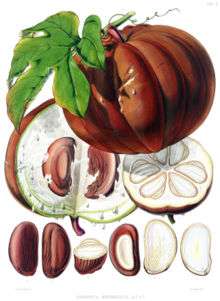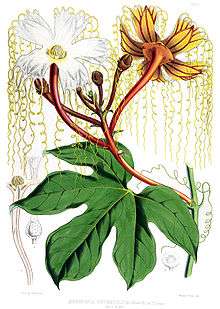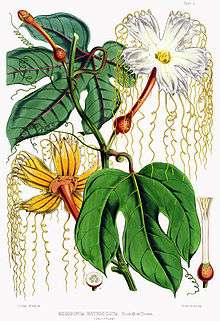Hodgsonia
Hodgsonia is a small genus of fruit-bearing vines in the family Cucurbitaceae.
| Hodgsonia | |
|---|---|
 | |
| Hodgsonia heteroclita fruit | |
| Scientific classification | |
| Kingdom: | Plantae |
| Clade: | Tracheophytes |
| Clade: | Angiosperms |
| Clade: | Eudicots |
| Clade: | Rosids |
| Order: | Cucurbitales |
| Family: | Cucurbitaceae |
| Subfamily: | Cucurbitoideae |
| Tribe: | Sicyoeae |
| Genus: | Hodgsonia Hook.f. & Thomson |
| Species | |
| |
Hodgsonia was named for Brian Houghton Hodgson in 1853 by British botanists Joseph Dalton Hooker and Thomas Thomson, who examined the plant under Hodgson's hospitality in the Himalaya.
Classification
Physical characteristics
- The flowers bloom for just one night, then fall off.[1]
| H. heteroclita | H. macrocarpa | |
|---|---|---|
| Leaf lobes | Usually 5 | Usually 3 |
Uses
Food
Although the flesh of Hodgsonia fruit is inedible and considered worthless, the large, oil-rich seeds are an important source of food. The kernels are occasionally eaten raw;[2] they are slightly bitter, possibly due to an unidentified alkaloid or glucoside, but "perfectly safe" to eat.[3] More commonly, the seeds are roasted, after which they taste like pork scraps or lard; many mountain peoples consider these roasted seeds a delicacy. In addition to eating the seeds alone, the Naga incorporate them into various types of curry.The Karbi Community of North East India continued to cultivate it in their backyard garden consume consume it as a side dish during a meal occasionally.They called it Hanthar Athe.[4]
Medicine
The medicinal importance of Hodgsonia is mostly in its leaves. In Malaya and java, native physicians report several uses for the nose. The leaves may be dried and burnt, and the smoke inhaled, or the juice of young stems and leaves is squeezed into the nostrils to allay irritation from small insects. The leaves are also boiled and the resulting liquid taken internally, both for nose complaints and to reduce fevers.[5] The ashes from burnt leaves of H. macrocarpa are also used to heal wounds.[6]
In Nagaland, the fruit bulb is applied to bacterial infections in the feet.[4] In Sarawak, Hodgsonia oil is used to anoint the bodies of mothers after childbirth; it also forms the base of embrocations carrying ashes from the leaves of coconut palm and Kaempferia.[7] The oil is also used as a base for medicines in Eastern India.[8]
History
Vernacular names

- In the north, H. heteroclita:
- In the south, H. macrocarpa:
- European languages:
Some of these names are ambiguous. "Kepayang" might mean Pangium edule, the "football fruit" tree whose aril is edible but whose large seeds are so laden with hydrocyanic acid that they are used as a powerful arrow poison. (The seeds can be prepared for human consumption; they are boiled and steeped in water, not roasted.)[15] "Kadam" can also mean Anthocephalus cadamba, a tree with much smaller fruit and minute seeds.[16]
References

- Loewer p.175
- Arora and Hardas p.560
- Hu 1964 p.170
- Changkija p.219
- Hu 1964 p.167, 171
- De Wilde & Duyfjes p.175
- Hu 1964 p.171
- Agarwal p.273
- Hooker p.16
- Arora and Hardas p.559
- Hu 2005 p.703
- Chowdhury p.94
- USDA p.2-304
- PLANTS Profile for Hodgsonia heteroclita (Chinese lardplant) | USDA PLANTS
- See, for example, .
- See, for example, Archived 2006-10-11 at the Wayback Machine.
- Agarwal, Vishnu Saran (2003). Directory of Indian economic plants. Dehradun: Bishen Singh Mahendra Pal Singh. ISBN 978-81-211-0289-6.
- R.K. Arora and M.W. Hardas (December 1977). "Hodgsonia heteroclita—An oil-rich cucurbit". J. Bombay Nat. Hist. Soc. 74 (3): 559–661.
- W.J.J.O. de Wilde and B.E.E. Duyfjes (2001). "Taxonomy of Hodgsonia (Cucurbitaceae), with a note on the ovules and seeds". Blumea. 46: 169–179.
- Changkija, Sapu (1999). "Folk Medicinal Plants of the Nagas in India". Asian Folklore Studies. 58 (1): 205–230. doi:10.2307/1178894. JSTOR 1178894.
- Chowdhury, M. (1996). "Bangladesh country report" (PDF). FAO international technical conference on plant genetic resources. Retrieved 2006-05-26.
- A.J.C. Grierson & D.G. Long (1983). Flora of Bhutan : including a record of plants from Sikkim. Edinburgh: Royal Botanic Garden. p. 263.
- Hooker, Joseph Dalton (1855). Illustrations of Himalayan plants. London: L. Reeve. pp. 15–23. LCC QK349.33 .H66 1855.
- Hsu Chien (November 1963). ""Lard fruit" domesticated in China". Euphytica. 12: 261–262. doi:10.1007/BF00027460 (inactive 2020-01-22).
- Hu Shiu-ying (1964). "The economic botany of Hodgsonia". Econ. Bot. 18 (2): 167–179. doi:10.1007/BF02862714.
- Hu Shiu-ying (2005). Food Plants of China. Hong Kong: Chinese University Press. pp. 703–704. ISBN 978-962-201-860-0.
- Loewer, Peter (2002). The Evening Garden. Timber Press. ISBN 978-0-88192-532-6.
- USDA. "Regulating the Importation of Fresh Fruits and Vegetables" (PDF). Archived from the original (PDF) on 2006-05-12. Retrieved 2006-05-26.
External links
| Wikimedia Commons has media related to Hodgsonia. |